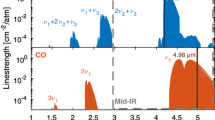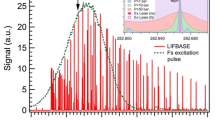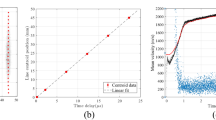Abstract
Laser-based diagnostic techniques offer unique capabilities for experimentation on gaseous flows. In this paper, we overview recent progress of two concepts: spectrally resolved absorption and planar laser-induced fluorescence (PLIF) imaging. The absorption measurements utilize tunable diode lasers (TDLs) as light sources. Recent TDL applications include a wavelength-multiplexed system for rapid temperature sensing for use in combustion control, and absorption probes for time-resolved measurements of temperature, velocity and species concentrations in a hypersonic shock tunnel. Recent PLIF work includes applications to supersonic, exothermic flowfields relevant to ram accelerators, and development of a method for imaging temperature in air flows using acetone seeding.
Similar content being viewed by others
References
Chou, S. I., Baer, D. S. and Hanson, R. K., “Diode-Laser Absorption Measurements of CH3Cl and CH4 near 1.65 μm,” Applied Optics, 36–15, (1997), 3288.
Clemens. N. T. and Paul, P. H., “Effects of Heat Release on the Near Field Flow Structure of Hydrogen Jet Diffusion Flames,” Combustion and Flame, 102–3 (1995), 271.
Furlong, E. R., Baer, D. S. and Hanson, R. K., “Combustion Control Using a Multiplexed Diode Laser Sensor System,” 34th AIAA Aerospace Sciences Meeting, Reno, NV, January 16–20 (1996a), paper AIAA 96-0756.
Furlong, E. R., Baer, D. S. and Hanson, R. K., “Combustion Control Using a Multiplexed Diode Laser Sensor System,” Twenty-Sixth Symposium (International) on Combustion (1996b), The Combustion Institute, Pittsburgh, 2851.
Furlong, E. R., Mihalcea, R. M., Webber, M. E., Baer, D.S. and Hanson, R. K., 1998, “Diode Laser Sensors for Real-Time Control of Pulsed Combustion Systems,” 34th AIAA Joint Propulsion Conference, Cleveland, OH (1998), paper AIAA 98-3949.
Hanson, R. K., Kuntz, P. A. and Kruger, C. H., “High-Resolution Spectroscopy of Combustion Gases Using a Tunable Infrared Diode Laser,” Applied Optics, 16–8 (1977), 2045.
Hertzberg, A., Bruckner, A. P. and Bogdanoff, D. W., “Ram Accelerator: A New Chemical Method for Accelerating Projectiles to Ultrahigh Velocities,” AIAA Journal, 26–2 (1988), 195.
Kamel, M. R., Morris, C. I. and Hanson, R. K., “Simultaneous PLIF and Schlieren Imaging of Hypersonic Reactive Flows Around Blunted Cylinders,” 35th Aerospace Sciences Meeting and Exhibit, Reno, NV, January 6–9 (1996), paper AIAA 97-0914.
Lozano, A., Yip, B. and Hanson, R. K., “Acetone: a Tracer for Concentration Measurements in Gaseous Flows by Planar Laser-Induced Fluorescence,” Experiments in Fluids, 13–6 (1992), 369.
Mihalcea, R. M., Webber, M. E., Baer, D. S. and Hanson, R. K., “Diode Laser Sensor for Combustion Emissions Monitoring,” Proceedings of VSJ-SPIE98, December 6–9, 1998, Yokohama, Japan (1998), paper no. AB059,
Morris, C. I., Kamel, M. R. and Hanson, R. K., “Expansion Tube Investigation of Ram-Accelerator Projectile Flowfields,” 2nd AIAA Joint Propulsion Conference, Orlando, FL, July 1–3 (1996), paper AIAA 96-2680.
Parr, T.P., Gutmark, E.J., Wilson, K.J., Hanson-Parr, D. M., Yu, K., Smith, R.A. and Schadow, K.C., 1996, “Compact Incinerator Afterburner Concept Based on Vortex Combustion,” Twenty-Sixth Symposium (International) on Combustion (1996), The Combustion Institute, Pittsburgh, 2471.
Philippe, L. C. and Hanson, R. K., “Laser-Absorption Mass Flux Sensor for High-Speed Air Flows,” Optics Letters, 16–24 (1992), 2002.
Rea, E. C., Jr., Salimian, S. and Hanson, R. K., “Rapid-Tuning, Frequency-Doubled Ring Dye Laser for High-Resolution Absorption Spectroscopy in Shock-Heated Gases,” Applied Optics, 23–11 (1984), 1691.
Tait, N. P. and Greenhalgh, D. A., “2D Laser-Induced Fluorescence Imaging of Parent Fuel Fraction in Nonpremixed Combustion,” Twenty-Fourth Symposium (International) on Combustion (1992), The Combustion Institute, Pittsburgh, 1621.
Thurber, M. C., Grisch, F. and Hanson, R. K., “Temperature Imaging with Single- and Dual-Wavelength Acetone Planar Laser-Induced Fluorescence,” Optics Letters 22, 251–253.
Wehe, S. D., Baer, D. S. and Hanson, R.K., “Tunable Diode-Laser Absorption Measurements of Temperature, Velocity, and H2O in Hypersonic Flows,” 33rd AIAA Joint Propulsion Conference, Seattle, WA, July 6–9 (1997), paper AIAA-97-3267.
Wehe, S. D., Baer, D. S., Hanson, R. K. and Chadwick, K. M., “Measurements of Gas Temperature and Velocity in Hypervelocity Flows Using Diode-Laser Sensors,” 20th AIAA Advanced Measurement and Ground Testing Technology Conference Albuquerque, NM, June 15–18 (1998a), paper AIAA-98-2699.
Wehe, S. D., Baer, D. S. and Hanson, R. K., “Diode-Laser Sensor for Velocity Measurements in Hypervelocity Flows,” submitted for publication to Optics Letters (1998b).
Yuen, L. S., Peters, J. E. and Lucht, R. P., 1997, “Pressure Dependence of Laser-Induced Fluorescence from Acetone,” Applied Optics 36-15 (1997), 3271.
Author information
Authors and Affiliations
Corresponding author
Additional information
R. K. Hanson: He received his undergraduate education at Oregon State University (B.S., 1961). Following two years of military service, he earned graduate degrees in mechanical engineering at Arizona State University (M.Sc., 1965) and in aeronautical engineering at Stanford University (Ph.D., 1968). Since 1971 he has been affiliated with the Mechanical Engineering Department at Stanford, where he is now the Woodard Professor and chairman. Dr. Hanson’s research has been in the fields of shock wave physics and chemistry, laser spectroscopy and diagnostics, chemical kinetics, combustion and propulsion. He is a Fellow of the Optical Society of America (OSA) and of the American Institute of Aeronautics and Astronautics (AIAA), and in 1996 he was the inaugural recipient of the AIAA Award for Aerodynamic Measurement Technology.
D. S. Baer: He received his undergraduate education in Engineering Physics at the University of California, Berkeley (B.S. 1982). Following 18 months as a Research Associate at the Desert Research Institute, Israel, he earned graduate degrees in Mechanical Engineering at the High Temperature Gasdynamics Laboratory (HTGL) at Stanford University (M.S. 1985, Ph.D. 1993) under the guidance of Professor Ron Hanson. Since 1993, He has been affiliated with the Department of Mechanical Engineering at Stanford University; his current position is Senior Research Scientist. He is currently involved in various applications of diode lasers including industrial process control, combustion monitoring, and spectroscopy.
Ted Furlong: He received his B.S. degree in Aerospace Engineering from the University of Texas at Austin in 1991 and his M.S. and Ph.D. degrees in Mechanical Engineering from Stanford University in 1994 and 1998, respectively. He is continuing his research on combustion control and advanced diagnostics with General Electric Corporate Research and Development in Niskayuna, NY.
Christopher Morris: He received his B.S. degree in Mechanical Engineering from Rensselaer Polytechnic Institute in 1992 and his M.S. degree from Mechanical Engineering from Stanford University in 1993. Currently Chris is working toward his Ph.D. degree in the High Temperature Gasdynamics Laboratory in the Mechanical Engineering Department at Stanford University under the guidance of Prof. R. K. Hanson. His graduate work involves laser imaging and modeling of shock-induced combustion in high-speed wedge and conical flows.
Shawn Wehe: He received his B.S. and M.S. in Mechanical Engineering from the State University of New York at Buffalo in 1988 and 1990, respectively . Afterwards he worked at Calspan Corporation in their hypersonics and propulsion department. He is working towards his Ph.D. degree in Stanford University’s High Temperature Gasdynamic Laboratory in the Mechanical Engineering Department under the direction of Professor Ron Hanson.
Mark Thurber: Following undergraduate study at Princeton University, he came to the Mechanical Engineering Department at Stanford University in 1992, receiving an M.S. degree in 1994 and a Ph.D. in April of 1999. His graduate research, under the direction of Prof. R.K. Hanson, focused on development of temperature and multiparameter imaging diagnostics using acetone vapor as a fluorescent tracer. He currently works on measurements of disk drive heads at IBM Storage Systems Division in San Jose, California.
Rights and permissions
About this article
Cite this article
Hanson, R., Baer, D., Morris, C. et al. Recent advances in laser-based diagnostics for gaseous flows. J Vis 2, 309–319 (2000). https://doi.org/10.1007/BF03181447
Received:
Revised:
Issue Date:
DOI: https://doi.org/10.1007/BF03181447




